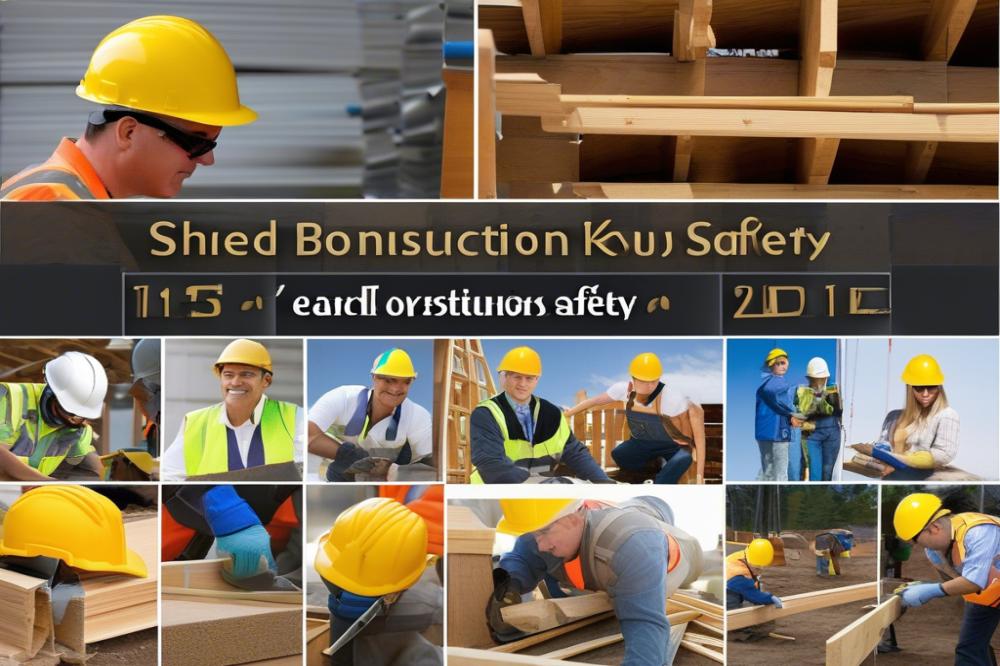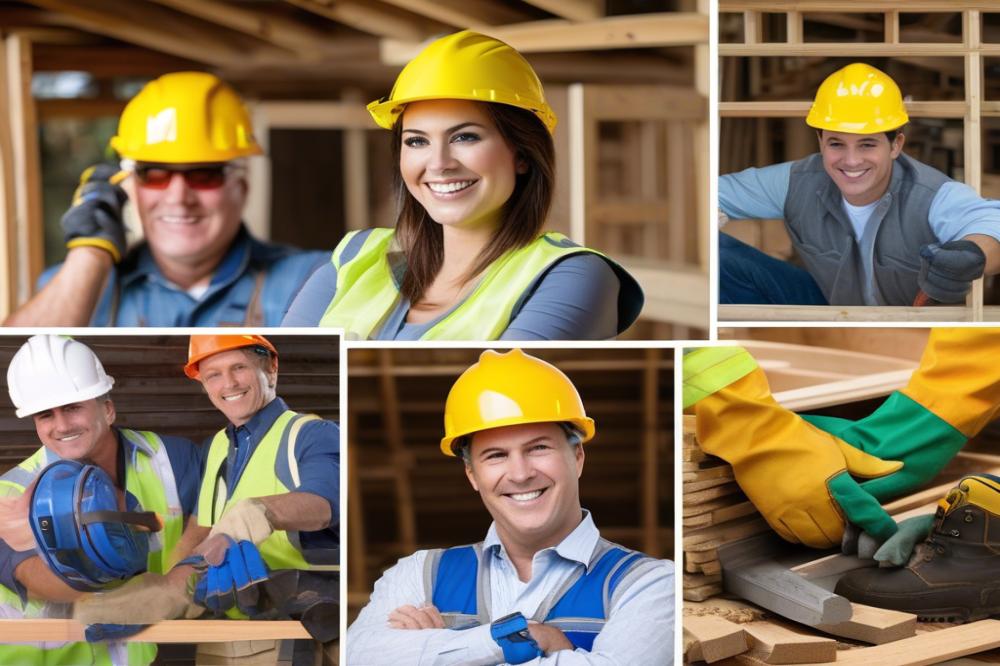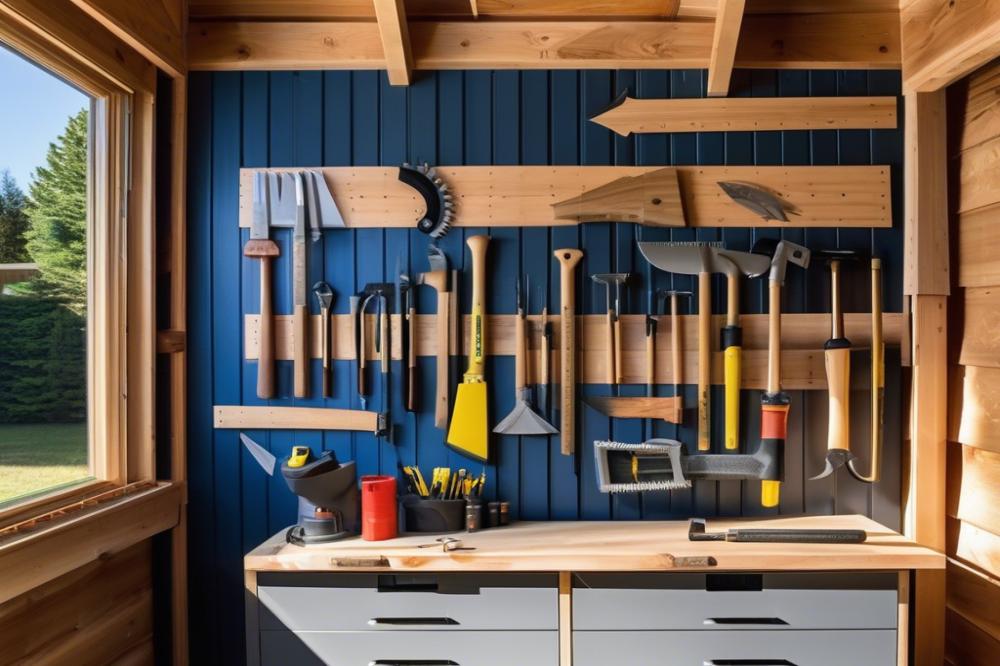Introduction
shed construction safety is crucial for anyone involved in building. Each project comes with its own set of risks. Builders often face numerous worksite hazards, which can lead to serious injuries or accidents. Staying safe is essential not only for personal well-being but also for successful project completion. When proper precautions are taken, the entire process becomes smoother and more efficient.
Focusing on safety tips can greatly impact builder health. Knowledge of potential dangers allows workers to prepare effectively. Among the key considerations are tool safety and ladder safety. Both tools and ladders come with specific risks that must be managed. Ignoring these risks can result in slips, falls, or equipment-related injuries, which can derail a project.
In addition, personal protective equipment is a must-have on any worksite. Wearing gloves, goggles, and hard hats can prevent injuries from common construction accidents. Fire safety should not be overlooked either, as accidental fires can occur during the building process. Being aware of surroundings contributes to overall site safety.
Weather considerations also deserve attention. Rainy or windy conditions can complicate construction tasks. Builders must adapt plans accordingly to ensure safety while working under challenging circumstances. Having a first aid kit nearby adds an additional layer of security. In the event of an incident, being prepared with basic medical supplies can make a significant difference.
Overall, building sheds safely relies heavily on these safety principles. Taking proactive steps will help create a safer work environment. By being informed and alert to possible dangers, builders can minimize risks and enhance the likelihood of project success.
shed construction safety: Key Considerations

When building a shed, safety is a priority. Understanding the risks involved can lead to better choices on the worksite. One of the first steps is identifying potential hazards that may arise.
Identifying Potential Worksite Hazards
Watch for tripping dangers, such as uneven ground or tools left lying around. Heavy materials can cause injury if not handled properly. It’s important to have clear pathways so that everyone can move safely. Sharp objects also pose risks; ensure that blades and nails are stored securely. Additionally, be aware of electrical hazards. Only use tools that are in good condition. Regular checks on power cords or outlets can prevent shocking accidents.
Understanding Site Safety Regulations and Guidelines
Familiarity with local safety regulations is crucial for any project. Regulations will outline what safety measures must be followed. For example, personal protective equipment (PPE) is often required. Hard hats, safety goggles, and steel-toed boots can protect individuals from injury. Ladder safety is another important topic. Always set up ladders on stable ground and avoid overreaching.
Fire safety is equally essential. Keep flammable materials away from heat sources. Having a fire extinguisher on-site can save lives. Be mindful of weather considerations, especially in extreme heat or storms. Rain can make surfaces slippery, leading to slips and falls.
Lastly, don’t forget a first aid kit. Each worksite should have one easily accessible. Training staff on how to use it can prepare them for emergencies.
Personal Protective Equipment (PPE)

Importance of PPE in shed construction
Personal protective equipment plays a vital role in construction safety. Every builder should recognize that worksite hazards can lead to injuries or accidents. Using PPE helps minimize risks associated with various construction activities. Builders can focus on their tasks when they feel safe and secure in their environment. It adds an extra layer of protection against unforeseen dangers. Safety is not just a guideline; it is a necessity on every job site.
Types of PPE to Use
A variety of personal protective equipment is essential for shed construction. Helmets protect your head from falling objects. Gloves are crucial for hand safety, as they prevent cuts and abrasions. Eye protection like goggles helps shield against dust and debris. It is equally important to wear sturdy steel-toed boots to protect your feet. Hearing protection should also be considered, especially when using loud machinery. When the weather changes, wearing weather-resistant gear can make all the difference. Each type of PPE addresses specific risks on the job, making it important to select them carefully.
Guidelines for Proper Use and Maintenance of PPE
To get the most from your PPE, follow some basic safety tips. Always choose equipment that fits properly; ill-fitting gear can reduce protection. Perform routine checks to ensure nothing is damaged or worn out. Cleaning and maintaining your equipment prolong its lifespan and effectiveness. Store PPE in a dry, accessible space when not in use. Encourage fellow workers to also wear their protective gear consistently. When going to the worksite, always pack a first aid kit. This ensures readiness for any minor accidents, reinforcing overall site safety. By adhering to these guidelines, builders can promote a safer work environment for everyone involved.
Tool Safety

Safe handling and operation of construction tools is vital. Each tool can pose specific risks if not used correctly. It is crucial to be aware of your surroundings when using power tools or sharp instruments. Always pay attention to what you are doing. This focus helps prevent accidents. Wearing personal protective equipment, such as goggles and gloves, should be standard practice. These items help protect against injuries from flying debris or accidental cuts.
Regular maintenance and inspection of tools cannot be overlooked. Before starting any project, check each tool for damages or defects. A worn blade or a loose cord can lead to serious injuries. Cleaning tools after use is also important. Dirt and rust can affect their performance and lifespan. Keeping tools in good shape ultimately enhances overall site safety.
Importance of user manuals and safety features is often underestimated. Manuals outline proper operation procedures and highlight safety tips specific to each item. Familiarize yourself with these guidelines. Safety features, like blade guards and emergency shut-off switches, are designed to protect users. Always utilize these features while working. They are there for a reason, and neglecting them can result in dangerous situations.
Each construction project comes with its own challenges. By following these safety tips, builders reduce the risk of worksite hazards significantly. Remember, being proactive about tool safety is part of overall construction safety. Take the time to plan and prepare before starting any job.
Ladder Safety

Choosing the Right Ladder for the Job
Ladders come in various types, each designed for specific tasks. Picking the correct ladder can greatly affect your safety. For instance, extension ladders are useful for reaching high areas, while step ladders are great for short heights. Check the weight limit before use. A ladder should support both the user and any tools being carried. Additionally, consider the material. Fiberglass ladders are non-conductive and perfect for electrical work. Metal ladders can pose a shock hazard. Always select a ladder that suits your worksite hazards.
Safe Ladder Setup and Usage
Before setting up a ladder, inspect it for any damage. Look for cracks, bends, or broken rungs. Place the ladder on stable ground, avoiding wet or uneven surfaces. Secure the base, if possible, to prevent slipping. When climbing, maintain three points of contact. That means two hands and one foot or two feet and one hand should always be on the ladder. Always keep your body centered on the rungs. This practice reduces the risk of falls, a common incident in construction safety.
Preventing Falls and Accidents While Using Ladders
Weather considerations can influence ladder safety. Never use a ladder during strong winds or rain. Slippery conditions can lead to tragic accidents. Wearing personal protective equipment like hard hats and non-slip footwear is crucial. When working at heights, a safety harness may also be necessary. Always avoid overreaching. Keep your movements balanced to maintain control. Additionally, take frequent breaks to avoid fatigue. Ensure that your tools are secured in a tool belt to keep hands free. Lastly, having a first aid kit nearby is smart if an emergency arises. These ladder safety tips will help keep your building projects safe and sound.
Fire Safety Considerations
Fire Hazards During Shed Construction
Shed construction presents various fire hazards that builders must recognize. Flammable materials such as wood, paint, and fuels often reside on site. Sparks from tools can ignite these substances quickly. Electrical tools can also pose risks if not handled correctly. Overheating wires or faulty connections can lead to fires. Nearby vegetation can catch fire if not properly managed, especially in dry weather. Working with open flames or heat sources requires extra caution. Builders should stay aware of their surroundings and potential sources of ignition.
Preventative Measures to Reduce Fire Risks
Taking precautionary steps can significantly reduce fire risks at a construction site. First, store flammable materials in a safe location away from work areas. Keep a fire extinguisher accessible to quickly tackle small fires. Inspect all electrical equipment for damages regularly. Always use personal protective equipment to ensure safety while handling tools. Workers should also practice good tool safety by using tools only for their intended purposes. Take care when using ladders. Secure them properly before climbing to avoid accidents. Doing so minimizes unnecessary risks and improves overall site safety. Maintain clear pathways on the worksite to prevent tripping hazards.
Emergency Response Plan and Fire Extinguisher Use
Every builder must have an emergency response plan in place. This plan helps ensure that everyone knows what actions to take in case of a fire. Hold regular drills to keep the team familiar with procedures. A well-stocked first aid kit should always be on hand for emergencies. Knowing how to use a fire extinguisher is just as important. Fire extinguishers should match the types of fires that could occur on the site. Workers must receive training on how to operate them effectively. Remember, safety tips are only effective when everyone follows them. Building a strong culture of safety can save lives and property.
Weather Considerations
Effects of Weather on Construction Safety
Weather can significantly impact construction safety. Rain can create slippery surfaces, increasing the risk of falls. Wind can make it difficult to operate ladders, and it can also affect the stability of structures. Extreme heat might lead to heat exhaustion among workers. Cold temperatures can make materials brittle and increase the chance of accidents. Builders need to understand these risks to maintain site safety.
Planning Construction Around Weather Forecasts
Before starting a project, it is wise to check the local weather forecasts. A planned construction timeline should consider seasons, as certain conditions might delay work. If rain is expected, adjust the schedule to avoid heavy downpours. Early planning can save time and resources. Communicating with the team about weather changes is equally essential. Workers should always be informed about the possible effects of changing conditions.
Protective Measures Against Adverse Weather Conditions
Taking protective measures is critical for safety on the job site. Personal protective equipment must be used according to the type of weather. In the summer, wear light clothing and stay hydrated to combat heat. During cold months, dress in layers and take breaks indoors to avoid frostbite. When strong winds are present, secure all tools and materials to prevent them from becoming projectiles. Always keep a first aid kit accessible in case of injuries resulting from unexpected weather events. Following tool safety protocols during inclement weather is also vital. It ensures that equipment remains functional and reduces the likelihood of accidents. Proper ladder safety is necessary in windy conditions as well. Builders must be cautious, checking the stability of ladders before use.
First Aid and Emergency Preparedness
Importance of Having a First Aid Kit on Site
Having a first aid kit on site is essential for every construction project. Accidents can happen anytime, and being prepared can make a big difference. A well-stocked kit provides critical medical supplies to treat injuries right away. Typical items include bandages, antiseptics, and pain relievers. Builders should regularly check the kit’s contents to make sure everything is up to date. Keeping it within easy reach can save time during emergencies. It’s also a good idea to include specific supplies for common injuries on the job, such as cuts and scrapes.
Basic First Aid Knowledge for Construction Workers
First aid knowledge is crucial for everyone on a worksite. Understanding how to handle minor injuries can prevent them from becoming major problems. For example, knowing how to clean and dress a wound can stop an infection before it starts. Recognizing signs of serious conditions, like heat stroke or severe bleeding, is equally important. Workers should feel confident using personal protective equipment when necessary. Regular training sessions on first aid can keep everyone’s skills sharp. These safety tips can empower workers to act quickly during an emergency.
Creating an Emergency Response Plan
Emergency response plans are vital for any construction project. They outline steps to take in different situations, like fires or severe accidents. Start by identifying potential worksite hazards and the specific risks associated with the shed construction you are doing. Assign roles to team members for various emergencies so everyone knows what to do. Make sure everyone understands the plan clearly. Discuss ladder safety and tool safety protocols as part of the response strategy. Regularly reviewing the plan can help keep it fresh in everyone’s mind. Knowing what to do when something goes wrong can greatly reduce panic and lead to better outcomes.
Final Thoughts on Safety in Shed Building
In summary, the importance of following essential safety tips during shed construction cannot be overstated. Proper planning, the right tools, and personal protective equipment play critical roles in keeping workers safe. Always remember to check the weather conditions before starting any outdoor project. Poor weather can create dangerous situations.
Adherence to safety practices must be a priority for every builder. By staying focused and mindful of potential hazards, individuals can significantly reduce the risk of accidents. Using tools properly and taking breaks to avoid fatigue further promotes a secure working environment. Building a strong safety mindset is key.
An effective culture of construction safety starts with everyone on the team. Encourage open discussions about safety practices. Sharing experiences and tips can help others learn. A team that communicates about safety will build more than just a healthy workspace; they will construct a solid foundation for future projects.



